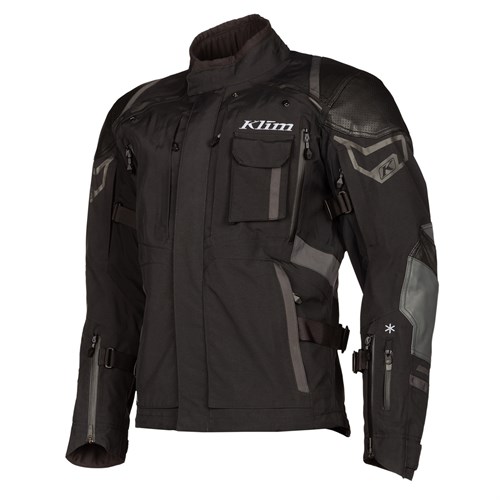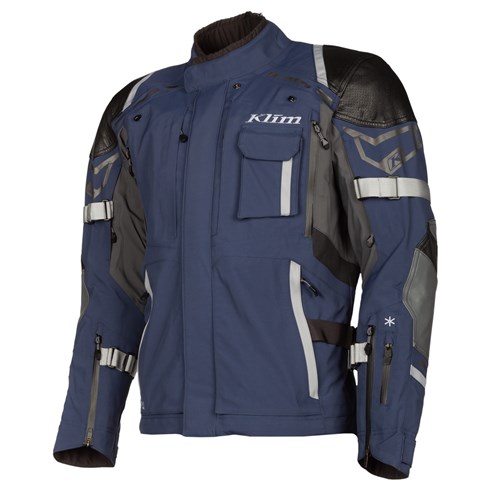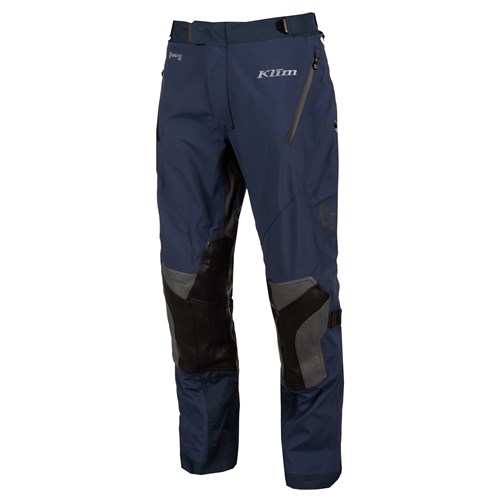Klim Kodiak 2 jacket review
Published on: 04 March 2021

If we are being totally honest, we would normally expect the European brands to be at the forefront when it comes to technical, motorcycle wear. But Klim is the one company that bucks this trend. Klim has most definitely become the foremost name in adventure wear, for example. They use only the very best components, such as SuperFabric, Gore-Tex, D3O, Koroyd and so on.
But there is something else even more important as far as Klim is concerned. We get bored with the oft-cited line: ‘Made by bikers for bikers’. In most cases, it’s a cliché’d piece of nonsense. It’s normally the go-to strap line for lazy marketeers who want to invest their products or services with an undeserved reputation for authenticity. The sad truth is that very few motorcycle clothing manufacturers even test their gear before it goes into production. Fortunately, Klim doesn’t use the aforementioned strap line, but of all the makers out there, they rightfully could. These guys go to extreme lengths to make sure that the gear they produce actually works in the field. Not enough space to go into it all here, but these guys are the real deal. Obviously, they’re a business; they have to make money. But what motivates everybody who works at the company is quite simply the pursuit of better gear.

It is this determination to do better that has led Klim to upgrade its Kodiak suit. Confusingly, Klim haven’t given the new suit a new name, so we will be calling it the Kodiak 2. Now the original Kodiak suit came out a couple of years ago. Having established their credentials in the adventure market, Klim decided that they wanted a slice of the much larger touring and commuting cake. Their first attempt was creditable, but if we are to be honest we would have to say that it was a stepping stone. The suit was a little mixed up, a little confused. It was a bit ‘adventure’ and a bit ‘touring’; it wasn’t perfect in either role. It wasn’t a bad suit; it just wasn’t the full monty. But Klim learned from their experience with the Kodiak 1, in order to create this much-improved second iteration.
The Kodiak 2 is similar in concept to its predecessor. That is to say that it has a much slimmer, more fitted shape than the baggy, more off-road focussed Badlands. Like the original incarnation, it is a Gore-Tex Pro Shell, laminated garment. It is well vented, has too many pockets, leather on the elbows and shoulders, D3O armour throughout, and so on. But a lot of effort has gone into making the new version more comfortable, without sacrificing functionality.

Whereas, on the previous Kodiak, you had gussets in the shoulders to aid articulation, on this version you have panels of Gore-Tex stretch material under the arms and into the shoulder area. Klim haven’t said anything in their technical specs., but we are also very much of the view that the new jacket uses a slightly lighter outer fabric; again, increased comfort being the ambition. Another contributor to increased comfort is the perforated, Gore, goatskin panelling on the elbows and shoulders. Again we think it is perhaps a little thinner than it was on the original Kodiak, but it is also cut differently. On the old version the leather panels made the shoulders and sleeves quite stiff. On this jacket, that’s no longer the case. As with all Klim jackets, there is a continued drive towards making the rider comfortable on the bike.
There is another change that helps to make the Kodiak 2 more comfortable; and you may think it can only be a marginal factor, but we would disagree. On the old version, the 3M Scothlite reflectors came in the form of ribbons sewn onto the outer fabric. Once again, a certain stiffness or rigidity was the outcome. But on the new version, the reflective panels are sewn into, or printed onto, the garment; and it does make a difference.
The bottom line here, in our view, is an unquestionable improvement in wearability. We haven’t done big miles in this jacket. We have been out in it, and many of us here have sat on the shop bike in it. But we’ve been doing this long enough, and we have developed sufficient critical faculties, to know that the Kodiak 2 trumps the Kodiak 1 when it comes to riding on the bike, but also in how it wears off the bike. Not quite chalk and cheese, but nonetheless the Kodiak 2 is a marked improvement.

Okay, let’s go on and talk about waterproofing and venting. Both important, but in some suits these two desirable features can fight against one another. As far as waterproofing is concerned, the suit is Gore-Tex Pro Shell, so it doesn’t get more waterproof than this. Both the stretch panels and the leather panels are also from Gore, so no water ingress issues there either.
Vents can be a weak point for water ingress, although that’s never historically been an issue for us on any Klim garment. The new Kodiak has two fewer vents than the previous version. It doesn’t have them up the flanks, but it’s still better vented than most of its competitors. So you still get two vents on the upper chest, two vents on the biceps, two vents on the forearms and two huge exhaust vents on the back. The zips at the ends of the cuffs are two-way; and this means that these can also be used as vents. The zips are still by YKK, but they are no longer Aquaseal zips. The Kodiak now uses the same zip as Rukka use on the Nivala. And we think Klim specified these zips, not to save money but, again, to increase comfort. As with the Kodiak 1, the jacket has a double storm flap, with a rain channel on the inner one, to prevent water getting in through the main zip.

As far as protection is concerned, you’ve obviously got the leather panels on the elbows and shoulders; and this will help as far as abrasion resistance is concerned if you do end up going down the road. Throughout the jacket, the D3O armour is Level 2, including in the back. The armour in the elbows and shoulders is adjustable. One thing that the new jacket doesn’t have that the old one did is a kidney belt cum lumbar support. That has fallen off the spec., but the jacket is still designed to take one, so this can be purchased as an optional extra.
The Kodiak 2 also has a chest pad, but unfortunately this doesn’t qualify as protective armour, and technically we cannot suggest that it has protective qualities. The pads are not certified under EN 1621, and in all honesty the pads don’t really look as though they’re up to much. Klim may not realise this, but anything that purports to offer protection should be CE certified, and these pads aren’t.

So let’s look at some of the other details on the Kodiak. The devil is in the detail, as some people are wont to say. All we know is that it can be the annoying little things that can make a jacket hard to live with. Anyway, here goes. Pockets. Two on the chest. Two billowed lower cargo pockets. A forearm pocket. A front utility pocket. Four internal pockets. And a hidden passport pocket, the location of which we are not permitted to divulge.
There’s an adjuster for the hem, a hook that allows you to hold the collar open to get air to the neck in hot weather. A jacket-to-pant zip. A breathable mesh lining and, what is a first for Klim, a removable Gore-Tex storm collar. But we are not done yet!

We’ve spoken about the comfort of the Kodiak jacket at some length already. And in our experience to get a jacket to work properly across a wide range of shapes and sizes, a jacket has to have a lot of adjusters. And the new Kodiak does. Now Klim claims that the neck collar is adjustable. That’s a slightly dubious claim, in our view. It’s just a piece of Velcro! You do, though, get adjustable straps on the biceps and forearms.
But the big step up from the old Kodiak is that this version can be cinched at the waist with elasticated straps. And this will make a huge difference, because a jacket that cannot be tightened or loosened on the waist is often going to rule out the very slim as well as those who are carrying a bit extra around the tummy. A jacket that cannot be cinched at the waist will also be subject to billowing and flapping in the wind when you’re riding at speed.

There’s one upgrade to the Kodiak that we feel that we may even have influenced. In our written and video reviews, we have always bemoaned the lack of adjustability at the ends of the cuffs on Klim jackets. This might be acceptable when you’re riding off road, because there’s not normally a requirement to tuck your gloves inside the sleeves of the jacket. But this is important for road riders who ride in the winter and in heavy rain. This we pointed out to Klim last year. Well, with zips and Velcro tabs, these sleeves now work as well as on any touring and commuting jacket. Thank you Klim, even if we had nothing to do with it! And as we’ve already pointed out, because the zip is two-way, it can also be used as yet another vent.

We’ve left to last one of the biggest upgrades on this jacket; and it has to do with its inner, thermal jacket. Now Klim’s waterproof garments are often known as ‘shell’ garments. And that means that most of Klim’s jackets have no thermal component. Coming from an off-road background, the thermal element was never the primary consideration for the American brand. Their solution was always to use the appropriate base and mid layers. But in a market where almost every other jacket comes with a thermal lining, Klim clearly felt that they had to step up.
Well, they have done; and in some style. They have, to be frank, taken Rukka’s lead. They have come up with a duvet-style jacket that comprises 90% goose down and 10% goose feathers. Don’t know whether the jacket’s going to be warmer than the Rukka, but it’s certainly smarter and works better as a street jacket. The down has a ‘fill-power’ rating of 800. We can’t go into what that means here, but it’s a measure of the insulating qualities of the filling. This rating could be 500 for a lightweight jacket or 1000 for a high-end mountaineer’s jacket, but 800 is impressive; a nice balance of weight and insulation. As with the Rukka, the Klim inner does not zip into the outer jacket. You wear it when it’s cold, and tuck it away somewhere on the bike when it’s not. Cleverly, there’s no stuff sack with the Maverik thermal jacket, as it is called. It actually just tucks into one of its own zip pockets. The outer fabric is meant to be windproof and has been treated with a Durable Water Repellant, but I wouldn’t get carried away by that; it will be useless in the rain. It really is a lovely jacket. You could turn up in it at a smart restaurant and nobody would bat an eyelid. And it is warm. I know this because I extensively tested the sample Klim sent us. You’re not going to climb Everest in one. For the bike, though, it’s just about perfect.

Normally, when we, or indeed anybody else, reviews a suit, all the effort and energy goes into the jacket, and sadly the trousers become a bit of an afterthought. Well, we are not going to break with tradition: this review, therefore, is no exception to that rule. So let’s discuss the pants as briefly as we can, whilst leaving out no important detail.
Okay, in nearly every respect, the construction of the jacket and the pants are identical. Gore-Tex Pro Shell. Gore-Tex stretch in the crotch. Gore goatskin on the knees. In the bum and down the inner side of the legs, you get a 600 denier Cordura overlay for added strength. D3O armour is fitted throughout. Vents on the front and backs of the thighs. Pockets. Adjusters. YKK zips. A wide opening at the hem to allow them to go over just about any boots. Connecting zip. Braces. And so on. So, that’s a brief run through. You can get more detail by going to the website. But all the attention to detail that went into the new jacket has also gone into these pants. And, of course, as you would expect of a Klim pant at this end of the market, the Kodiak pant comes in three leg lengths.

But there’s a ‘but’ when it comes to the Kodiak 2 suit, and it’s potentially quite a big ‘but’. It doesn’t have to be, but for some this ‘but’will be enough to put them off it. And the ‘but’ is this. Under EN17092, the Kodiak is only rated A, instead of the AA that we would have expected, and indeed contrary to what Klim had planned it to be. On one level, an A rated suit at this price point is simply beyond the pail, but things aren’t quite as bad as they might seem and, if you will permit us, we will explain what is going on here, and why.
Now Klim had expected the new suit to be accredited at the AA level, as indeed the previous Kodiak 1 had been. The problem is under the arms and in the crotch area where Klim has put stretch panels to increase comfort levels. These small panels do not deliver the level of abrasion resistance required to meet the AA standard. So how big a deal is this? Well, the reality is that on both the jacket and the pants, in an accident there is very little danger that these stretch areas will come into contact with the road. In theory, it’s possible; in reality, it’s unlikely.
Take a look at the diagram below. You can see that, on both the front and the back, the stretch panels fall into the yellow zone. This zone covers a large area, and it is more than likely that those who drew up the zoning realised that the areas under the arms and in the crotch were not particularly vulnerable. But by the same token, they were minded to keep the zoning as broad as possible so as not to make it too confusing and difficult for manufacturers. It would probably not have made sense for them to have created extra little green areas under the arms and legs, even though they would probably have known that the areas we are talking about didn’t technically need to reach the higher level.

We apologise for this lengthy and detailed explanation, but we felt it was necessary. The Kodiak 2 is an amazing suit. It is wonderfully comfortable, and full of pleasing functionality and detail. And, despite this problem under the arms, we would contend that this is a very safe suit. It will be a great shame, and to some degree a gross injustice, if people pass over the Kodiak 2 for this one minor, technical failing. Yes, it’s a shame; but Klim tell us that the suit will run its course. It will remain an A rated suit for the foreseeable future. If you are put off the Kodiak 2 because of this, we understand. That is any buyer’s prerogative, and we understand this. However, because the suit is so outstanding in many other regards, we would suggest that you should make an effort to try it on before you make a final decision.
Finally, just to clarify one point. The sample we had for our review was blue, but in terms of our stockholding we will be majoring on the black version. We should always be able to get the blue version in from the main European warehouse within a matter of days.
Our conclusion? Well, the new Kodiak 2 is better than its predecessor. It is no longer an off-road outfit masquerading as a road outfit. It is a thumping good suit; absolutely a match for the best from Rukka, Stadler, Belstaff, Halvarssons or anybody else. The cost is not inconsiderable. The suit puts it in the same ballpark as the Nivala; currently it’s a bit less than the new Rukka Kingsley. And that’s where it deserves to be. The A rating may be the deciding factor for some, but if you’re going to be investing this kind of money in a suit, you should try it on first and compare it with some of the other contenders. Only then will you really be able to make a decision.
If you want to do this, well, you know where we are!
Share this story






































































